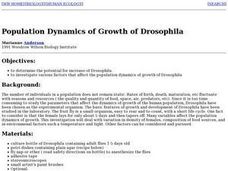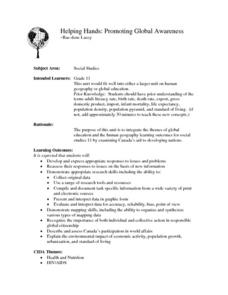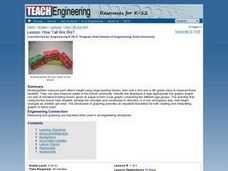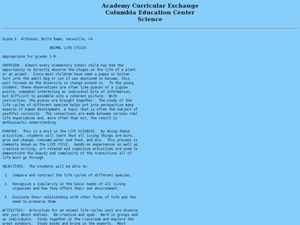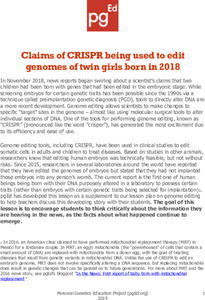Curated OER
Population Dynamics of Growth of Drosophila
Young scholars experiment with Drosophila to determine if density of female flies, food sources, temperature and light affect the population dynamics of growth. Students graph their data and compare their results to the number of human...
Curated OER
Population Dynamics of Growth of Drosophila
High schoolers investigate population dynamics such as variation in density of females, composition of food sources an environmental factors such as light and temperature on Drosophila. They then relate their findings to human...
Curated OER
Helping Hands: Promoting Gloval Awareness
Eleventh graders explore Canadian support for foreign aide. In groups, 11th graders discuss Canadian aide policies and express their opinion of each. Students brainstorm methods of contributing to developing nations. They complete...
Curated OER
History of Wildlife Management Lesson Plan
Students explore how others maintain the balance between humans and wildlife.
Curated OER
The Role of the Government in Lead Poisoning Prevention
Students examine a general overview of the issues around lead poisoning in order to become more aware of the dangers and effects it has on the human body. They investigate how and why various government agencies and laws were...
Curated OER
Street Children - A Topical Lesson Plan From Learn.co.uk
Middle schoolers explore poverty-related issues, use research, discussion and class work to further understanding of situations in developing countries,
and discuss and compare Students own school life with that of children in...
Curated OER
The Laughing Leaf
Students demonstrate real-object writing. They discuss a leaf that has human attributes, and using a real leaf write a story about a leaf that tells them a joke, and create an illustration of themselves and their leaf.
Curated OER
Salaries
Students are engaged in the study of salaries and how they vary according to different occupations. They conduct research using a variety of resources in order to summarize the earnings potential in the human services field.
Curated OER
Once a fact, always a truth
High schoolers discover there are many sources of accurate and inaccurate information. They use newspapers and, in small groups, develop a statement explaining why they believe the article is accurate or inaccurate.
Curated OER
Anatomy of the Brain
Students explore the brain. In this science lesson, students view a diagram of the brain and discuss the various regions of the brain. Students discuss the importance of protecting the brain and design a protective covering.
Curated OER
How Tall Are We?
Students in a Kindergarten class measure each other's height using large building blocks and then visit a 2nd and a 4th grade class to measure those students. They display the results in bar graphs, comparing the different age groups.
Curated OER
What does it mean to be a citizen?
Students examine democracy and the role of a citizen. They contrast rights and responsibilities of individuals, groups, and organizations. Students identify two forms of democratic action and describe demoncratic values. Students observe...
National Institute for Literacy
Making Sense of Decoding and Spelling
Go over digraphs, vowel sounds, and affixes with a series of decoding and spelling lessons. Each lesson guides learners through a different reading and phonics skill, building on the lesson before, and challenging them with each step.
Curated OER
Exploring the Soul of India
Students use websites to obtain information on the relationship between religion and current issues in India. They compare the information with pre-20th century India.
Curated OER
Got a problem? Let's Solve It!
Young scholars understand what problem solving means and that problems can be solved in different ways. For this problem solving lesson, students discuss real life problems in groups and present their solution. Young scholars create...
Curated OER
Cancer: A Crisis of the Cells
Students analyze cancer data represented in graphs and charts. They describe the changes in cell structure and function as the result of cancer. They also examine phenomenas that are believed to cause cancer.
Curated OER
P.O.W.: Products of War
Tenth graders are introduced to concepts of war through musical lyrics. They demonstrate and understanding of the role of segregation in US military policy and practice.
Curated OER
Taking Care of a Baby
Caring for a newborn is harder than it looks! Elementary pupils learn more about taking care of babies with an age-appropriate lesson that addresses how babies grow inside their mothers, what they need to grow, and how members...
Curated OER
Animal Life Cycle
Students conduct hands-on experiments. In this life cycle lesson, students are able to observe a variety of animals as they travel through their life cycle (brine shrimp, mealworms, frog eggs and chicken eggs). Students respond to what...
What affects Frog metamorphosis?
In this lab, students explore pollutants which affect frog metamorphosis using household pollutants (vinegar, oil, and bleach) and sponge capsules.
Curated OER
Puberty Changes- Lesson 1
It may take a few clicks to find this lesson on the Alberta Health Services website, but it's well worth it. This is Lesson 1 in a series of six lessons. After setting up the ground rules, discuss puberty and the changes that affect...
Curated OER
The Life Cycle of a Butterfly
A well-designed lesson on the life cycle of the butterfly is here for you. In it, young scientists spend 45 minutes a day, for one school week, engaged in their study. They take nature walks, participate in activities in centers, listen...
Personal Genetics Education Project
Claims of CRISPR Being Used to Edit Genomes of Twin Girls Born in 2018
Here is an activity that blends genetic technology, literacy skills, and critical thinking. Pupils review background information about cell lines and CRISPR by video and teacher-led discussion. Scholars collaborate to analyze two...
NASA
Freshwater Availability Classroom Activity
This science assignment produced by NASA teaches inquiring minds the distribution of Earth's water. Learners will appreciate and understand the importance of fresh water and how weather and climate affects everything.
